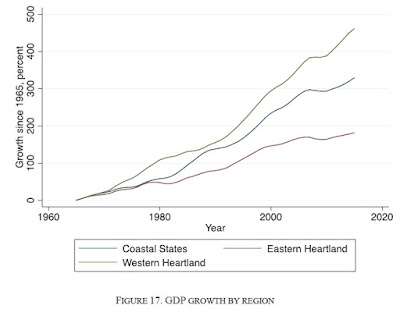But some economists are rethinking the mertics of place-based policies. Benjamin Austin, Edward Glaeser, and Lawrence H. Summers have written "Saving the heartland: Place-based policies in 21st century America ," for the Spring 2018 issue of the Brookings Papers on Economic Activity. As they argue, we seem to have entered a time when geographic mobility is down and when regional convergence of incomes has dropped off. They write:
"America’s western frontier may have closed at the end of the 19th century, but there was still a metropolitan frontier where workers from depressed areas could find a more prosperous future. Five facts collectively suggest that this geographic escape valve has tightened: declining geographic mobility, increasingly inelastic housing supplies in high income areas, declining income convergence, increased sorting by skill across space, and persistent pockets of non-employment. Together these facts suggest that even if income differences across space have declined, the remaining economic differences may be a greater source of concern. Consequently, it may be time to target pro-employment policies towards our most distressed areas. ...The paper has a bunch of figures showing differences across these three regions. Here are figures on economic growth, the share of prime-age men not working, and mortality rates for men across these three regions.
"We divide the U.S. into three regions: the prosperous coasts, the western heartland and the eastern heartland, The coasts have high incomes, but the western heartland also benefits from natural resources and high levels of historical education. America’s social problems, including non-employment, disability, opioid-related deaths and rising mortality, are concentrated in America’s eastern heartland, states from Mississippi to
Michigan, generally east of the Mississippi and not on the Atlantic coast. The income and employment gaps between three regions are not converging, but instead seem to be hardening ..."
What would place-based policies look like? As the authors point out, such policies can be explicit or implicit. For example, an infrastructure policy like the Tennessee Valley Authority is explicitly aimed at a certain geographic region. However, an infrastructure project like the federal highway system, or a program like flood insurance, will clearly have specific geographic effects for those closer to highways or at higher risk of floods, without actually naming a certain geographic area. After mulling the options, they suggest that targeted employment subsidies may be the best bet. They write:
"The best case for geographic targeting of policies is that a dollar spent fighting non-employment in a high not working rate area will do more to reduce non-employment than a dollar spent fighting non-employment in a low not working rate area. The empirical evidence for heterogeneous labor supply responses to demand shocks or public interventions is limited, but broadly supportive of the view that reducing the not working rate in some parts of the country is easier than in other parts of the country. ... While infrastructure remains an important investment for America, targeting infrastructure spending towards distressed areas risks producing projects with limited value for users. By contrast, enhanced spending on employment subsidies in high not working rate areas, and perhaps the U.S. as a whole, seems like a more plausible means of reducing not working rates."For those interested in this approach, here's an earlier discussion of "What Do We Know about Subsidized Employment Programs?" (April 25, 2016).


